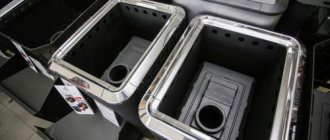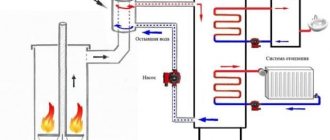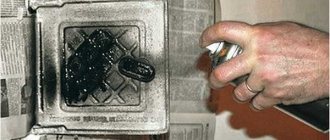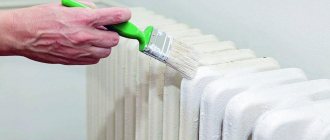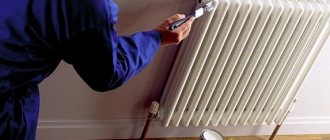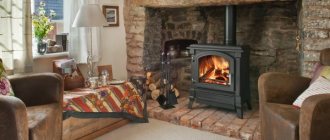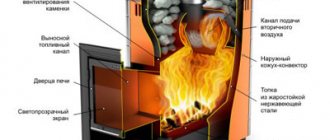Types of paint
Here is a list of some of the leaders in this type of product:
- Paint for sauna stoves made of metal “Termal” from Finnish, produced in black or silver from alkyd resin. The coating is guaranteed not to be damaged for 3 years. When the stove surfaces are heated to 200 0, the paint completely hardens within 60 minutes. Bottled in containers of 330 g.
- Hansa paint has high heat-resistant properties and is available in both aerosol cans and liquid form. Available in 16 shades of color. Does not lose its properties when heated to 800 0, can be applied to stainless steel.
- One of the best representatives of silicone enamel, which can withstand temperatures up to 600 0, is the domestic coating of the Kudo brand. Available in aerosol cans with a capacity of 520 mg.
- Paint produced only as a spray coating with heat resistance up to 650 0 - “Bosni”. During use it does not crack, does not change color and does not fade. It is used to cover glass, metal and ceramic surfaces. Packaged in 400 mg cans. For glass it is produced with heating temperatures up to 200 0.
- Hammerite paint protects steel surfaces and can be applied over rust. When preparing, it is not recommended to use gasoline or diesel fuel as solvents. Withstands heating up to 600 0 . Apply to the surface using a roller and brush in 1 layer, immediately painting the surface of the structure.
- ELCON enamel has high anti-corrosion and heat-resistant characteristics. Withstands heating up to 800 0 and sudden temperature changes. Available as aerosol paint in 0.5 liter cans and bottles.
Army railway potbelly stove cast iron USSR
- Product type: Fireplaces and heaters
- Condition: New
Stoves with DELIVERY 24 hours. + Chimney pipes, Scoops, Pokers + Cauldrons.
All potbelly stoves have the same dimensions and weight, all are new.
Furnaces from Reserve. NOT China, NOT remade, NOT steel.
Read the information below.
Prices for preserved stoves:
-Ovens without inscription. Complete set - oven and bottom, WITHOUT grate and lid - for a cauldron or grill - 3.800.
- Stoves without brand and year. Complete set: oven, bottom, grill, lid. 5.500
- MPS is much better quality - 6,000. Complete set: oven, bottom, grill, lid.
- - Armavir - so-called “officer” stoves. Complete set: oven, bottom, grill, lid. - 7.900.
— Kaganovich from 14.500.
— Height 60.0 cm. Diameter 33.3 cm. Weight 60-62 kg. The wall thickness is about 10mm!!
— Tank for connecting water heating! The price of the tank is 3000 (only when purchasing a stove) - this is not available from other sellers of potbelly stoves.
— Poker and scoop 300 RUR/set, from the same times.
— Galvanized/stainless steel pipes at 300/700 r/m – new! There are elbows, valves and umbrellas, gates and insulation.
— Circles for a cauldron 1 piece for 1000 rubles or + poker and scoop for 1500 (all new)
— Sandblasting + painting for conventional stoves 1800-2000. For Armavir and Kaganovich for 3000 rubles
In stock + delivery 24/7 for only 700 rubles inside the Moscow Ring Road
Call during the day, I will advise you on all questions.
- Works on any solid fuel - firewood (up to 35 cm), coal, briquettes, solid waste.
— Stoves were produced from the 30s to the 60s. This is a PROVEN DESIGN!
— High strength, no cast iron was spared! They were counting on decades of operation in harsh conditions.
— Used in the Army and on the railway.
- Complete set - cast body, bottom, grate, lid - all cast iron.
— The price for modern stoves of the same class is much higher.
Coloring instructions
Having learned how to paint the stove in the bathhouse, you can purchase paint and prepare the stove for painting.
Tools and materials
To do the work yourself you will need:
- paint, preferably in aerosol cans;
- if you use liquid paint in cans, you will need to purchase a roller and brush;
- sandpaper to remove a layer of rust;
- metal brush;
- when cleaning large areas, use a grinder;
- solvent for degreasing parts;
- for painting you can use a spray gun and a compressor, especially with large dimensions of the structure;
- rags;
- paper or old sheets to protect the surface of walls and floors when painting.
Having dealt with the question of how to paint an iron stove in a bathhouse and having prepared the materials necessary for the work, you can begin to carry out the preparatory work.
Surface preparation
To do this you will need to perform a number of simple works. But surface preparation must be approached with full responsibility; this determines how the paint will adhere to the metal and how long its layer will withstand high temperatures:
- Using a metal brush, we clean the stove from adhering dirt, soot and rust;
- Clean the finished surfaces with fine sandpaper. This work will make the surface smooth, remove minor scratches and irregularities;
- sweep and remove dust from the stove parts;
- Having generously moistened a rag with solvent, degrease all surfaces;
- If the stove has parts made of stainless steel or those that have undergone galvanic treatment, there is no need to paint them. Therefore, we will apply a layer of grease or other lubricant to the parts;
- cover the surface of the floor and walls next to the heater, paper or cloth.
Paint application algorithm
We know how to paint an iron stove in a bathhouse, the necessary preparatory operations have been completed, now you can move on to the main stage of work. This will not require much time and effort. All work is carried out in the following sequence;
- open and stir the paint well. If it is thick, it can be diluted with a solvent suitable for this enamel. Be sure to read the instructions and dilute the paint only with the specified mixtures. Otherwise, you'll just throw away a can of expensive paint;
- if a spray gun is used to apply the layer, the paint is diluted to a more liquid state, then poured into the spray gun through a painting sieve or the wife’s old tights;
- first apply a layer to all inconvenient places and edges of the oven and only then treat the surfaces, slightly overlapping the previous layer. When painting with a brush, the work is done in the same way;
- The paint is applied in 1 layer, so do not allow any gaps, painting all surfaces evenly.
Work is done. Now leave the oven until the enamel has completely hardened.
It is important to close all doors and windows to prevent dust from entering the room. For some paints you will need to light the oven; they only harden when heated.
Therefore, carefully read the instructions and strictly follow these rules.
How often should I paint in the future?
Paint for an iron sauna stove will last for the period specified by the manufacturer
You need to pay attention to this characteristic when purchasing enamel.
Expert opinion
Pavel Kruglov
Stove maker with 25 years of experience
The minimum period for high-quality surface coating for most manufacturers is 3 years
But the frequency of use of the stove and its operating conditions are of no small importance.
In any case, if the stove is made of thin metal, it may fail before the paint coating of the surfaces. Paint is a short-lived coating, so every bathhouse owner should be prepared for repeated work to protect the stove.
Is it possible to achieve a durable protective layer on the surfaces of the heater? Yes, in this case, performing a simple galvanic method of protecting the metal will help.
Important recommendations and useful tips
Diagram of a cast iron stove.
For painting brick stove structures, it is more preferable to use enamel paints rather than oil paints, because... they are characterized by much higher heat transfer. In this case, it is recommended to give preference to dark shades. Do not use glossy paints for this type of work, as... their heat transfer is extremely low.
To prevent the yellowing effect, add a little blue to the solution. If you wish, you can decorate the stove with various patterns. The most convenient way to do this is with the help of special stencils, which allow you to apply sophisticated and sophisticated patterns to the surface. Do them after the stove is completely painted. For applying patterns, a composition consisting of gouache, clean water and egg white is best suited. Mix the components thoroughly and use the resulting solution to apply beautiful and original patterns.
In the absence of lime, a chalk-based composition can be used to paint the potbelly stove. The result is an equally high-quality and attractive result. This solution is prepared in exactly the same way as a lime-based mixture.
When choosing a paint, you must pay attention to whether it is resistant to high temperatures and whether it will not emit toxic fumes when heated.
To prepare leveling putty, you can use not only brick flour and eggs. If desired, the egg white can be replaced with high-quality latex paint. Buy any paints and materials only from trusted places. Be sure to ask the seller for certificates for the products presented. This will allow you to avoid unnecessary costs and disappointments after finishing your potbelly stove. To apply paint, it is recommended to use good brushes with natural bristles. This tool ensures a thin, uniform and highest quality application of the finishing material.
Thus, the potbelly stove can be painted using chalk, lime or special factory paint. These are the main and most common finishing options for such structures. Think, choose the most suitable option for you and get to work. Good luck!
Which one is better to use?
How to paint a metal stove in a bathhouse? To do this, it is necessary to buy heat-resistant or organosilicon enamels, varnishes that can withstand heating up to 6000. The layer must maintain its solidity and prevent the formation of rust on the structural steel from which inexpensive bath “units” are made.
As a rule, dark colors are used, even black. It increases the heat transfer level of the furnace. Aluminum based paint is not recommended. The most in demand are organosilicon enamels from Russian and foreign manufacturers. It contains:
- organic resin;
- aluminum powder;
- organic radicals;
- silicon base and oxygen.
Now let's look at specific brands:
- The leader among domestic brands is Cetra. Available for different heating temperatures. Black enamel can withstand heating temperatures up to 9000.
- Another heat-resistant paint, produced in cans and having good properties at a low price, is heat-resistant enamel of the Kudo brand.
- Among foreign manufacturers, we can highlight the Finnish “Thermal” from.
How to paint a metal stove in a bathhouse from the inside? For this it is better to use fireproof paint. Its only disadvantage is its high price.
Choosing what to paint the stove in the bathhouse with
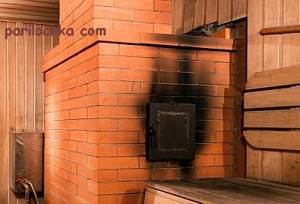
If you did not buy a stove in a store, but made it yourself or to order, then you will most likely be faced with the question: how to paint the stove in the bathhouse? But not only a metal stove needs painting in a bathhouse. Read about everything related to stoves and paints below.
- What kind of stove is made of metal?
- Brick
What kind of stove
So, some are looking for how to paint a stove in a metal bathhouse, while others are interested in how to paint a brick stove - we have answers to both questions.
Made of metal
Metal stoves for bath procedures are made of either steel or cast iron. Both circumstances are not particularly significant when choosing paint - it is much more important that the paint be particularly heat-resistant , because it will have to withstand the temperatures of a hot stove.
Requirements for paints for iron sauna stoves
A sauna stove differs from a regular fireplace in that the metal in this case is constantly affected by a number of negative factors, both from the inside and the outside:

- cold and hot water;
- steam fumes;
- increased room humidity;
- high temperatures due to burning wood or coal.
As for the material from which the device is made, stainless steel is usually taken. But even in this case, it is necessary to coat it with a special paint composition to increase its service life.
The main factors taken into account when choosing a paint coating:
- resistance to constant temperature changes;
- corrosion protection;
- moisture-repellent properties of paint;
- low toxicity.
Attention! You should not purchase paint of dubious manufacture, on which the standard properties and composition of the components are not specified. Buying such a counterfeit could lead to stove repairs.
Heat resistance
Regular exposure to high temperatures is one of the most important characteristics that you should pay attention to when choosing a coating. Product certificates must specify the maximum possible heating temperatures.
Metal corrosion protection
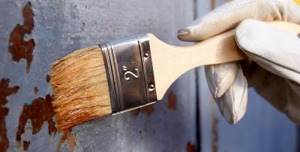
There are special paint compositions that are resistant not only to high but also to low temperatures, which is a definite plus.
After all, the stove is not heated every day, so it is advisable to take this factor into account when choosing a protective coating for the winter period.
When the furnace heats up, the metal expands, so it is desirable that the constituent components of the paint in the form of special additives significantly increase the service life of the furnace.
Important! The usual paint composition can withstand temperatures up to 80 degrees, and the heating of a sauna stove can reach 200 degrees or more, take this into account when selecting a paint coating
Water repellent properties
Constant exposure to steam, cold and hot water, alternating heating of the stove, especially in the steam room of the bathhouse, greatly affects the strength of the metal. Therefore, moisture resistance is the most important characteristic when selecting paint.
Composition safety
High temperature, affecting the paint, provokes the release of toxic fumes, so you should choose only high-quality and certified paint and varnish compositions. Lack of a certificate may result in poor health or poisoning.
How to choose heat-resistant paint for stoves
When choosing paint to cover the stove, you must adhere to the following rules:
- it must be resistant to steam;
- have a high level of surface protection from temperature changes;
- must prevent the formation of corrosion;
- ability to withstand temperatures from 80 to 750 degrees;
- Possibility of use in dry and wet environments.
There are paints on sale that were developed specifically for brick and metal stove structures . For some ovens, it is possible to use mixtures in various combinations or simply use one type of heat-resistant paint.
The paint must be of high quality. If the paint material is of poor quality, then when heated it may begin to release toxic substances. The product must be certified. The documents must clearly indicate what maximum temperature the composition can withstand and what substances it will release during the heating process. If there is no certificate, it is better to refuse such a purchase, because a low-quality product can have a bad effect not only on the quality of finishing work, but also on people’s health.
Lime painting preparatory stage
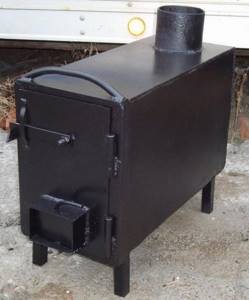
Rice. 1. Potbelly stove made of metal.
A potbelly stove can be made of metal. This design is shown in Fig. 1. The oven can also be made of brick. Stoves can be painted using different finishing materials. Thus, for finishing brick structures, an affordable and fairly high-quality material called lime is often used. To paint a potbelly stove yourself, prepare the following required materials, fixtures and tools:
- Brushes and rollers;
- Bucket;
- Solvent (can be replaced with alcohol);
- Enamel in aerosol;
- Lime;
- Water;
- Dyes;
- Glue.

Construction of a potbelly stove made of metal.
Before painting the potbelly stove, you need to prepare a solution suitable for this. Take a bucket or other container, add lime and fill it with the same amount of water. After this, mix the mixture thoroughly and add animal glue to it. You can purchase this glue at a store that specializes in selling various painting supplies. You will need relatively little glue - about 100 g per 10 liters of solution. Before you add glue to the lime mortar, be sure to dilute it in a separate container (an ordinary bucket will do) with a small amount of water.
To understand whether a lime-based solution is ready, you need to do the following: take a small piece of glass, fix it vertically and apply a little solution. If the paint spreads no more than 3 cm, then everything was done correctly, you can begin finishing the stove.
If you want to paint your potbelly stove not white, but some other color, then you will need to add a little dye to the solution. Potassium permanganate, blue or synthetic paints can be used as a dye. The specific option is selected depending on what shade you want to get.
Painting a potbelly stove lined with bricks
How to paint a potbelly stove made of brick? Choose a product based on the information offered by the manufacturer:
- heat resistance 200-900 degrees;
- you can choose low anti-corrosion indicators (high ones are needed for working with metal);
- lack of sensitivity to sudden temperature changes;
- dense coating in the form of a solid opaque film, it is better if it is enough to apply once to obtain the desired pigmentation;
- matte or glossy finish – it doesn’t matter.
An oil base is not the best solution . Enamel is suitable for you - it has a low level of heat transfer.
In dark colors, imperfections are less visible - unevenness, bumps, depressions. White, beige and derivatives produce errors.
If you need to get a pattern, use a mixture of gouache, protein and water to make images “on wet”. For this you need a thin soft brush. Additional pigment is applied to the still wet layer of paint to create neat, smooth drawings.
Here are the heat-resistant paint options:
- Thermika KO 8111 (Russia),
- Pyrolac 180 (Greece),
- Pyrolac 580 (Greece),
- Nobiles Termal 500 (Poland),
- Barpimo (Spain),
- High Heat Paint (UK),
- Elcon 600.
You can also prepare the paint yourself. To do this you will need varnish, PF-283 turpentine, and gouache of a certain color. If you do not add gouache, the coating will turn out matte and opaque. Ingredients, except dye, are added in equal proportions.
Painting technology
- To carry out the work you will need a wide and thin brush. It is better to choose hard pile. If you need to pre-putty the surface, spatulas are useful.
- The dye should be applied to a clean, prepared surface. First, the first thin layer is created. After it dries, you need to check if there are any gaps. If any are found, a second layer is applied.
- After processing the brickwork, they begin to coat the cast iron elements. The surface must be cold during all procedures.
Any material is suitable for the work. Chalk, crushed to a low fraction, may also be useful. Lime is heat-resistant in any case. You can buy an armored packaged product or a weighed one.
Painting technology
- lime;
- roller or brush;
- canister, bucket or other container for mixing;
- prepared solvent (can be replaced with an alcohol solution);
- enamel (spray);
- dye (color pigment);
- water;
- glue.
- Use a scraper and brush to remove dirt and dust. We treat cracks. We remove old paint and remnants of other coatings.
- Use a nano-alcohol spray or a special degreaser.
- Using a cleaned brush, the surface is re-treated until the degreaser has dried.
The application technology consists of the following stages:
- using a roller, apply the prepared lime-based composition (we begin work immediately after cleaning and preparing the surface);
Lime application technology
Doors and handles are painted after a full range of work has been carried out on the stove body.
You only need to choose heat-resistant varnish. Silver will do the job perfectly - a brilliant composition that allows you to hide unevenness and visually hide bumps and depressions on the surface of the stove. Silver lasts a long time, the coating is not thick, and dries quickly. You can buy the finished product or silver varnish separately, then dilute it. When dry, silverfish can catch fire, so storage should be in a safe place.
Painting technology
You will need a brush, a spatula to remove the old coating, a sponge for applying degreaser, varnish and additional color components, and a container for possible dilution.
Stages of work:
- surface preparation – cleaning, degreasing with alcohol;
- adding pigment or silver to the varnish, if provided (or working with pure varnish);
- the first layer is applied thinly, you need to wait until it dries;
- a second layer is applied, then a third.
Coloring bath equipment
Elevated temperatures, high humidity, frequent heating and cooling cycles cause rusting not only of the sauna stove, but also of other metal structures located in the steam room. This primarily concerns the tank intended for hot water. It needs to be painted not only from the outside, but also from the inside, since the water in it will cause corrosion.
Painting the tank is carried out according to the same rules listed above. The only difference is that it needs to be coated with paint and varnish at the manufacturing stage. Once it is installed, such work will not be possible.
In addition to the tank, it would not be superfluous to paint the heat exchange system and the chimney pipe, which rusts quite quickly. It is better to paint boilers and other metal surfaces that the steam room is rich in at the same time. When answering the question of how to paint the tank and other metal surfaces of the bathhouse, the already mentioned paints and varnishes should be mentioned.
In addition to other advantages of painting stoves, tanks and other structures, it is also necessary to highlight the fact that cracks can appear on hot metal (especially cast iron) when it comes into contact with water. Thus, the painted stove can be safely used in a room with high humidity.
Types of paints and their differences from each other
You can use different paints to apply a protective coating:
- water-based acrylic;
- organosilicon;
- polyurethane.
Water-based acrylic painting material is very convenient and affordable. The downside is that it can only be used for stoves located in rooms with low humidity, so this option is not suitable for saunas.
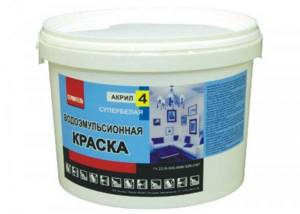
Photo 1. A jar of white water-based acrylic paint. .
Polyurethane paints are more heat-resistant and can withstand heat up to 600 degrees, it all depends on the constituent elements and additives in the paint. Study the composition in detail
Please note that polyurethane mixtures may change color when heated.
Organosilicon paint and varnish enamels are considered the most environmentally friendly and durable. They are able to withstand temperatures up to 800 degrees. There are no toxic substances in the composition, so their use is safe. The only downside is the high cost.
Types of paints
As already noted, not every paint will withstand the test of a hot surface and high humidity. Therefore, when intending to paint the stove and water tank, you should be very careful when choosing a paint composition. Special products are based on silicone or other substances containing silicon. With sufficient heating (up to approximately +150°C), polymerization occurs, as a result of which the paint fuses into a durable film that can withstand all types of external influences and prevent rust. The most well-known compositions include the following types:
Advantages of paint KO-8101
- Paint KO-8101. The most affordable option, guaranteeing a service life of up to 15 years.
- Varnish KO-85 based on organosilicon. Shows excellent results in conditions of high humidity, is not afraid of rust, but the maximum temperature withstand is only 250 degrees, and this may not be enough.
- Enamel KO-8111. A high-quality composition that not only provides the necessary level of protection and meets environmental requirements, but also pleases with a wide range of shades.
- Heat-resistant paint "Certa". Quite popular in the CIS countries, it has the additional name OS-82-03T.
- Enamel KO-8222. A coating that has the best heat resistance, up to 800°C. Because of this advantageous property, it has a high price.
In addition to painting the sauna stove, you need to take care of the hot water tank; special attention should be paid to treating it from the inside. There are several “old-fashioned” methods for this:
- Application of aluminum powder provides not only protection against rust, but also environmental safety.
- A solution of lime and cement in equal proportions. The water tank is coated inside with this mixture and dried.
- Treatment with red lead, which can be easily purchased in stores.
A number of modern means have been developed with which you can forget about the problem of rust forever:
- Anti-corrosion composition TsVES No. 2, containing zinc powder and ethyl silicate.
- The already mentioned heat-resistant “Certa”. The service life of the coating in a bathhouse is 7 years or more.
- Zinc-containing enamel "Ekotsin". Additionally, it protects against mechanical damage, which is a significant plus: the walls of the tank will not be scratched when you are trying to get rid of scale.
- Enamel KO-422. Treatment with this composition is called “cold galvanizing”.
Painting a metal stove that is not covered with plaster or brick
If the heating device in the house is not finished with anything, but it urgently needs to be updated, then you are probably wondering how to paint the potbelly stove in this case. Let’s say right away that not just any paint is suitable for this. The fact is that during operation, the stove can heat up to a very high temperature, and, of course, not all finishing materials can withstand such conditions. Only heat-resistant types of paints made on the basis of silicone and silicon are suitable for painting. Only in this case will the potbelly stove retain its original appearance for a long time.
Video - Powder painting
Information about heat-resistant paints
Using heat-resistant enamels, not only the desired design is achieved, protecting the surfaces of the potbelly stove from the penetration of dirt, but also resistance to high humidity. Moreover, all metal elements will be protected from rust and oxidation. Such compositions are produced mainly in the form of suspensions, and are based on heat-resistant varnishes that contain silicone and silicon.
3 Options for making a potbelly stove
Previously, we talked about how to make different versions of a potbelly stove yourself. We advise you to read this manual right now, see details here
Such enamels are produced in jars or in spray cans (spray). If stone surfaces are painted, the material is absorbed into the porous structure of the surfaces and forms a thin film on them, which, in fact, is a protective layer.
Note! In addition to the protective properties already mentioned, heat-resistant paints give heating appliances elegance and decorativeness; the walls of the furnaces look brighter and more aesthetically pleasing.
Now - straight to work!
Preparing equipment and supplies
Do I need to paint or is there an alternative?
Owners of homemade metal stoves do not always resort to painting them, apparently believing that this is done solely for the sake of appearance, and if the stove is not visible under a brick screen, then it is not worth spending money on painting it.
In principle, any metal will burn out over time. After all, why do cast iron stoves last so long? Their wall thickness is many times greater than that of steel, which is why they burn out longer.
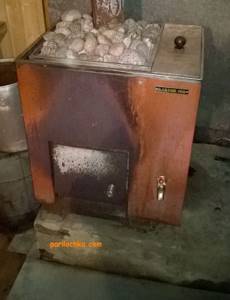
Castor stove - factory paint scorched
The paint layer prevents not only the metal from rusting from water, but also its burnout (also corrosion, by the way). Therefore, painting, in general, is beneficial, but such a coating also does not last forever (although there is a guarantee for many years). Therefore, let’s say this: if it’s cheaper for you to weld a new stove than to paint it, then it’s clear that you won’t paint it.
Unfortunately, by applying water to the stones, you still contribute to the oxidation of the metal. Steels rust quickly, and even stainless steels without certain additives oxidize when exposed to high temperatures. And black (carbon) steels generally rust instantly.
But silicone paints did not always exist; was there any alternative?
Yes, I was. Metal can be blued. Moreover, this applies to both steel and cast iron. With the help of various reagents or reagents and high temperature, a protective film of oxidized iron is formed on the surface. It is logical to assume that ordinary rust should also then be considered a protection - this is partly true, but it is loose, so it does not interfere with the further penetration of oxygen.
The film obtained by bluing (= blackening) metal is much stronger. It can be obtained using acids or alkalis. One way is as follows:
15 grams of tartaric acid and 280 grams of concentrated phosphoric acid should be poured into a liter of water. Use the resulting solution to treat a metal surface that has been cleaned to a shine. Wash off excess acid with laundry soap.
And then heat the stove to 150 degrees and apply a layer of caustic soda (NaOH) to the surface - you can spray it with a spray bottle, but with great care - caustic soda leaves chemical burns not only on the skin, but also on the respiratory system
IMPORTANT! When working with chemicals, protect your skin, eyes, and nasopharynx!
After an hour the surface will be black. Be sure to preheat the oven!
There are, of course, methods of cold bluing, but there are different ingredients. If you can get antimony trichloride, mix it half and half with olive oil and rub it into the surface prepared with acid and laundry soap (as described above). The paste is applied once a day, the next day it is completely removed and a new layer is applied.
If all these procedures seem too dangerous and time-consuming to you, you can simply cover the stove with either a stainless steel or a brick screen, but this will not really help save it from corrosion. Consequently, either unsafe bluing or expensive thermal paint.
Preparing to paint the potbelly stove
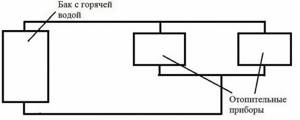
Scheme of a potbelly stove with a water heating tank.
If the potbelly stove installed in your home has not been finished with plaster, it must be painted. Not every paint is suitable for performing such work, because during operation the unit heats up to a fairly high temperature, and not every finishing material is able to withstand such conditions. In this case, you can only use heat-resistant silicon-organic based paints. Then the beautiful appearance of the potbelly stove will remain for a long time. To paint a potbelly stove yourself, you will need the following materials, tools and equipment:
- Container for preparing the solution.
- Drying oil.
- Hammer.
- Dye.
- Tassels.
- Red brick.
- Solvent for enamel.
- Milk and egg white.
Before starting work, it will be necessary to thoroughly clean the surface of the unit from dirt, various deposits and dust, and repair cracks, chips and irregularities. Putty will help you with this. Keep in mind that ordinary putty will not work for this type of work. You will need to prepare the solution yourself. Take a hammer, a red brick and crush it into small pieces until it turns into flour. Pour the resulting flour into a container, add 10 egg whites and beat thoroughly. The result will be a fairly thick mixture, which will need to be used to seal all the chips and cracks on the surface of the stove. To do this, use a hard brush.
Treat this step responsibly and you will get a smooth surface without defects. This putty guarantees reliable removal of defects. It is characterized by high resistance to heat and abrasion.
Before painting, treat the entire surface with drying oil. This will reduce the consumption of heat-resistant enamel and ensure better paint application. The drying oil layer should be thick enough, because... the brick will absorb a significant amount of this material.
Blueing of a metal furnace
Burnishing is a chemical treatment of the surface of iron. Using a similar method, they protect the metal from rust and give it a certain decorative look.
To burnish metal you need:
- Clean the surface until a characteristic shine appears. The service life of the decorative layer depends on its purity.
- Remove oxides. To do this, you can dilute 4 grams of butyl alcohol and 150 grams of phosphoric acid in a liter of water.
- Remove any remaining acid. Dilute 50 grams of laundry soap in a liter of water and wash the surface with this solution.
- Heat the oven to 150 degrees.
- Apply caustic soda. The preferred method is spraying.
Once the surface has dried, the iron will be protected from corrosion.
Video: how to make caustic soda yourself?
Popular types of paints and varnishes for sauna stoves
Paint for a metal stove is quite in demand, so it is not difficult to find it on the modern market. The most popular fireproof paints are:
- Organosilicate products have long been known to a wide range of consumers, as they are used for various works. People who ask the question: “How to paint a stove?” first of all remember these paints. They can withstand temperatures up to 600 degrees.
- Some types of spray paint have increased heat resistance. They can withstand temperatures up to 650 degrees and can be applied in almost any environment, such as sub-zero temperatures or electrostatic fields. Heat-resistant aerosol paints are perfect for painting a boiler in a bathhouse.
- A sauna stove can be painted with electrically conductive paints, but it should be remembered that they have one significant drawback: the ability to reduce heat transfer.
If you want the decorative finish to maintain high aesthetic values for a long time, then painting the sauna stove should be done with products from well-known brands that have been on the market for a long time. Popular manufacturers value their reputation and sell products that have the characteristics stated on the packaging.
How and how to paint a potbelly stove - step-by-step instructions
A potbelly stove is an excellent heating device for a private home. Over time, the aesthetic qualities of the potbelly stove deteriorate, so painting may be required. The technique of applying the coloring composition and the direct selection of products for the work are important points that it is recommended to pay special attention to.
- How to paint a cast iron stove?
- Paint selection
- Application sequence
- Final works
- Painting a potbelly stove lined with bricks
- paint
- Lime
- Varnish
- Burnishing for metal furnace
- How often should you paint?
- Conclusion
Painting procedure
Now you can start painting the potbelly stove. Before applying heat-resistant silicon-organic enamel, make sure that the prepared solution is not too thick. If you coat the surface with a viscous compound, it will not absorb well into the surface. In addition, such paint is quite difficult to work with. Therefore, first dilute it using a solvent specially created for organic materials. If you do not have such a solvent, you can dilute the paint using ordinary turpentine.
When the required thickness has been achieved, begin painting the potbelly stove. The paint should be applied in a fairly thin layer and wait until it dries completely. Then you need to apply a second layer. If the enamel lays down in an even layer through which the brick cannot be seen, you can complete painting at this stage. If the bricks are still visible, then you will need to apply an additional layer, and only after that paint the cast iron structural elements.
How often should you paint?
Maintaining a marketable appearance is the main goal of the home owner, who noticed that the potbelly stove was slightly deteriorated in appearance. If chips or scratches appear on its surface, it’s time to renew the coating.
Coloring is a simple procedure. It usually lasts several days due to the need to apply 2-3 layers, between which it is better to wait at least a day so that the material dries well.
It is important to use high-quality materials and tools - this will be reflected in the result. The main thing is to wait until each layer dries, clean the surfaces well, and work with gloves.
For painting, enamel paints that are resistant to high temperatures, lime, and varnish can be used. When choosing, proceed from the desired effect and cost of the material.
Painting an iron stove
High temperature, excess humidity, cycles of alternating heating and cooling, all this affects the metal structure - actively destroying its surface. It is clear that paint and varnish materials must withstand all this without losing their physical properties, maintaining an aesthetic appearance and protecting the metal from corrosion.
What kind of paint
Heat-resistant silicone enamel is well suited. Its abbreviation begins with the letters “KU”. Next come the numbers. There are brands that remain resistant to temperatures of six hundred to seven hundred degrees. In addition, heat-resistant silicone enamel reliably tolerates moisture, steam and cycles of sudden heating and cooling. In addition, the influence of high temperatures improves the adhesion index to the substrate.
There are also special fire-resistant paints. However, their purpose is to protect or maximize the time before the surface ignites. Therefore, such paints are not designed to create a particularly aesthetic appearance. They are certainly effective, but the price...
The “favorite” color covering most stoves is black or close to it. This is due (and not without reason) to the fact that such a color scheme provides better heat transfer. Well, maybe someone remembers the term “absolutely dark body” (this does not apply to people from the African continent). Therefore, most heat-resistant paints are dark in color. By the way, there are enamels that can be applied at negative temperatures. This expands the usability.
“For information: the temperature inside the firebox of an average sauna stove does not exceed 800°.”
Preparatory stage: If there are traces of dust or dirt on the surface, remove. Wash off with soapy water, scrub, etc. After that, degrease the surface. Acetone and white spirit are suitable for this. If there is rust or scale, carefully brush it with an iron brush, sand it and treat it with a solvent. Wait until completely dry. When using organosilicon enamel (KO), use “classic” solvent, such as P-646 and similar analogues, or turpentine as a solvent.
“If the stove is new, “freshly cooked” - heat it. This will allow you to “burn out” the remaining fats, grease and other debris accumulated in the pores and microshells, from where it is problematic to get them out with an ordinary rag.”
How to paint
The paint is applied in 2-3 approaches. Try to make a thin layer, this will prevent the formation of smudges. Before proceeding to the next layer, test for tack. Complete drying of the paint occurs during the first firing of the furnace, and at 150-200° its polymerization begins, or, more simply, sintering. After which, it gains its maximum strength.
Good advice on the painting process
Having figured out how to paint a potbelly stove, all that remains is to give some tips regarding painting. As noted above, to paint brick structures, it is advisable to use enamel-based paints (it is better not to use oil-based compositions, since they have a fairly high heat transfer rate). Moreover, give preference to dark shades. It is also undesirable to use glossy paints, which are characterized by low heat transfer rates.
In order to prevent the yellowing effect, it is recommended to add a little blue to the coloring composition. If desired, the potbelly stove can be decorated with some patterns. For this purpose, it is most convenient to use special stencils, thanks to which neat and sophisticated designs can be applied to the walls. Obviously, this should only be done when the potbelly stove is painted. It is recommended to apply patterns with a composition that consists of protein, water and gouache paint. All ingredients are thoroughly mixed, and the resulting mixture is used to create unique and beautiful designs.
Note! In the absence of lime, a mixture made of chalk can be used to finish the heating device. As a result, the surface will be just as high quality and just as aesthetically pleasing. Typically, this mixture is prepared in the same way as lime-based, only from chalk.
When choosing the paint to be used for painting, make sure that it (the paint) is resistant to elevated temperatures, as well as whether toxic substances or fumes will be released when heated.
You can prepare leveling putty not only from crushed bricks and chicken eggs. If possible, eggs can be replaced with good quality latex-based paint. By the way, paint, as well as other consumables, should be purchased only from trusted retail outlets. In this case, the seller must provide a certificate for the products he sells. This way you will be able to avoid not only unnecessary expenses, but also disappointments that may arise after painting the stove.
Finally, when painting, use high-quality brushes made from natural bristles. With the help of such tools, you can obtain a uniform and thin application of the finish, and of fairly high quality. You can see another way to paint a potbelly stove in the video below.
